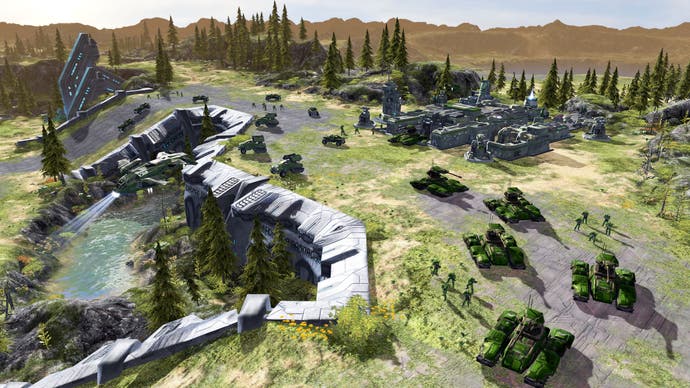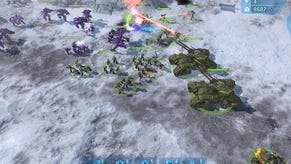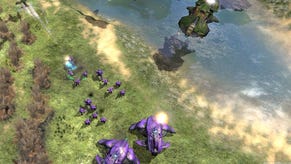Halo Wars
Warthogs and all.
The strange thing about Halo Wars is how understated it all seems. How dignified. There are so many ways that Halo Wars is an important game - it's real-time strategy on console, it's Halo in a new genre, it's Ensemble's swansong, it's another blow in the console wars - but while they could easily dominate your thoughts as you play it, they don't. Instead they just evaporate in the face of such a confident, self-assured and elegantly constructed videogame.
It lacks a little flair at times, but Ensemble has always excelled with this kind of small-c conservative design. If you look at the recent trend of RTS on consoles - taking in everything from the forthcoming Stormrise by Creative Assembly to Ubisoft's Tom Clancy's EndWar - Ensemble's game is most like the traditional RTS. Tweaks for the format are small, but meaningful, and they mostly work. Anyone who's played PC RTS has had a tendency to look on console incarnations as though it's sex with a couple of condoms on, but Ensemble's got it down to one extra-thick Durex: awkward, but still fun.
Halo Wars is also rather neat because it's an RTS prequel to a series originally conceived as an RTS. As expected, it tells the story of armed conflict between the Covenant, the UNSC and The Surprise Guest Oh I Wonder Who They Could Be. The story's not told particularly well, and isn't directly relevant to the game's charms, but it's an excuse to cram all your favourite bits of Halo's universe into an RTS: if you've shot it, shot in it, stole it or been annoyed by it while making your way through the Library, and if those events took place in a Halo game, you'll find it here, converted into an RTS, but working just as expected.
The key conventions of the RTS remain intact. While there are a few missions that vary things a little, it all grows from your management of a base. It manufactures resources, which you can then spend on improving your economy by making stuff that makes more stuff, or by improving your troops in term of quality or quantity. Levels are won when the enemy, who is trying to do the same thing, is defeated. Woo! The controls that would form a traditional PC RTS are crammed onto the controller, scrolling with a stick and selecting with the A-button. Shortcuts include being able to select all units or all units onscreen with the bumpers, scrolling faster with the trigger, and jumping between bases and/or danger alerts with the d-pad.

What makes it work isn't in the controller configuration, but what you actually control. Judging what you can manage is what makes Halo Wars sing. Take the bases, which you can only construct on pre-designed points. They open slots where you can construct your buildings (for PC veterans, think Kohan 2 or Rise of Legends), so the strategic questions are immediately clear. You have a new base. You have three slots. Which of your buildings do you fill them with? Alternatively, do you upgrade your base to get more? You're not scrolling around the map trying to find bits and pieces, but have a central position where you know they all are.
The base almost acts like a radial selection menu, allowing swift and decisive economic actions. Things are similarly well-judged on the research side. To access more powerful units and structures, you require reactors. Each reactor you build - or capture, as there are some spread around the map to be fought over - opens up further options. In terms of individual units' power-ups, they're mostly found in the same structure that built the unit, on the opposite side of the radial menu. If it's on the right, it's about making stuff. If it's on the left, it's about making stuff better.

This elegance only really falls apart in one of the research structures, where a few of the more generalised research abilities are collected. It's easy enough to grasp that everything else goes here, but when a few options apply to a specific subgroup (for example, adrenaline boosters to make your troops run quicker) you suspect they may have been better positioned over with the troop-making structures. If you choose to play Covenant - in skirmish or multiplayer, as the campaign is UNSC only - it's a little trickier to get a hang on them. They're really the advanced race, with more things that seem counterintuitive compared to the humans in terms of working out how they advance. Also, playing through the campaign before heading into open play does mean that it acts as an extended training sequence for UNSC - something the Covenant lacks.
The biggest strength for both though is the fact that most people understand the Halo universe. It's not just the geek thrill of seeing a Scarab in action - it's that you understand what the Scarab means on the battlefield (trouble). We know which characters are best against tanks, and which are probably best in special vehicles. Over on the special ability side - also well-judged, with everyone's abilities activated by the Y-button and members of the subgroup selectable with a trigger - some of the more unusual abilities are also familiar. Take the Spartans, who are able to take over most of the Covenant vehicles. You quickly realise in multiplayer that while the Covenant are able to churn out tanks quicker than the UNSC, it's something of a double-edged sword when you're just delivering a spanky new car to our boys in the green hats.









